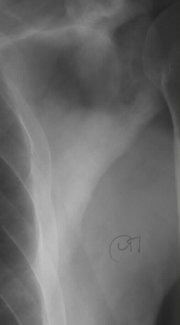In 1876 Sir James Paget, surgeon extraordinaire to Queen Victoria, described a male patient whose skull had thickened so much that he needed a larger hat. The man suffered from Paget's disease of the bone, a disorder that affects up to 3% of people over age 55 in the United States. Fortunately, most of these folks will never even know they have the disease. For those who develop troubling symptoms, however, effective treatments are available.
Throughout life the skeleton is constantly remodeled. Large cells called osteoclasts secrete enzymes that break down or resorb bone. In healthy bone the activity of osteoclasts is balanced by that of osteoblasts, cells that secrete collagen and other proteins needed to form new bone. Paget's disease develops when abnormally large pagetold osteoclasts resorb areas of bone at a faster rate than usual. In trying to make up for this accelerated loss, the osteoblasts form irregularly patterned new bone that is weaker, although often thicker, and contains more blood vessels than normal.
Researchers don't know what causes Paget's disease. The disorder seems to be relatively common in North America and Europe and is rare in the Middle and Far East. Some scientists believe that a viral infection may be to blame, but they haven't been able to isolate a virus from pagetoid osteoclasts. Other researchers favor a genetic explanation because as many as 30% of people with Paget's have a close relative who also has the disease. Doctors don't recommend screening people with a family history of the disorder since the chance of getting Paget's disease, let alone having bothersome symptoms, is very small.
Unpleasant surprise
Most people find out that they have Paget's disease by accident. This sometimes happens when a routine blood test turns up an elevated level of alkaline phosphatase, an enzyme produced in excess when osteoblasts are overworked. Or a radiologist may notice pagetoid lesions on an x-ray taken for something else. The bones most likely to be affected are the spine, pelvis, skull, tibia (the shin bone), femur (the thigh bone), and humerus (the arm bone stretching from the shoulder to the elbow). When a blood test turns up an elevated level of alkaline phosphatase, physicians order a bone scan to locate the abnormal sites. X-rays then help rule out other possibilities such as metastatic cancer that has spread to the bone. In most cases, Paget's disease progresses so slowly that x-rays taken at yearly intervals will show little change.
Doctors estimate that about 10% of people who have Paget's disease experience symptoms. Dull, aching pain that occurs when nerves are compressed by small fractures or thickened patches of pagetoid bone is most common. Some people develop arthritis-like symptoms when Paget's disease affects a joint. Others notice an unpleasantly warm patch of skin over a pagetoid lesion due to increased blood flow to the area. In some cases a visible deformity such as a thickened skull or curvature of the thigh or shin bone develops.
One in five people who have symptoms will experience more serious complications. These problems are most likely to occur when Paget's disease affects the skull. Thickened bone may impinge on a vital nerve and cause deafness, numbness of the face, or, in rare cases, blindness. When Paget's disease develops in the j aw, dental extractions may be complicated by excessive bleeding. In some cases back pain results from pressure on the spinal cord. Very rarely people with Paget's get osteosarcoma, a form of bone cancer.
Help for aching bones
Doctors don't treat Paget's disease unless a person has symptoms. For pain relief, nonsteroidal anti-inflammatory drugs like aspirin or ibuprofen are usually effective.
When Paget's disease impinges on the spinal cord or thickens the skull, more aggressive treatment is required to inhibit bone resorption. Doctors have a choice of two types of drugs, bisphosphonates or calcitonins, and they don't always agree on which to use first. Both work by inhibiting osteoclast activity.
Two bisphosphonates are approved for the treatment of Paget's disease in the United States: etidronate (sold as Didronel tablets) and pamidronate (Aredia), which must be injected. Two versions of synthetic calcitonin -- human and salmon -- are available in the United States. Both forms must be injected, although a nasal spray may soon be available.
Because etidronate inhibits both bone formation and resorption when taken for long periods, doctors typically prescribe the drug for four to six months followed by a four-to-six-month rest. Pamidronate is administered intravenously as a single four-hour infusion for three consecutive days. For severe cases, the treatment is repeated six to nine months later. When calcitonin is used, patients need to give themselves a daily injection, which is tapered to two or three times a week or discontinued altogether when alkaline phosphatase levels have fallen.
Each drug may have unpleasant side effects. Etidronate and pamidronate can cause nausea and diarrhea and can exacerbate bone pain in some people who have extensive Paget's disease. Calcitonin occasionally causes pain at the injection site, abnormal taste sensation, flushing, and nausea. Calcitonin is twice as expensive as etidronate, which costs about $50 a month.
Sometimes the two drugs are used alternately when people don't respond to either taken alone. Physicians monitor whether or not a particular treatment is effective by measuring alkaline phosphatase levels. When bone resorption slows, less new bone is made and less alkaline phosphatase is produced. Surgery is necessary in rare instances when Paget's disease affects a hip or knee joint.
Most people who have been diagnosed with Paget's, however, won't ever need to seek treatment. For many who unsuspectingly harbor the disorder, Paget's disease is one case where what you don't know won't hurt you. But when the condition causes pain, help is available. For more information, call the Paget's Foundation at 1-800-23-PAGET
COPYRIGHT 1995 Copyright by President and Fellows of Harvard College. All Rights Reserved
COPYRIGHT 2004 Gale Group



